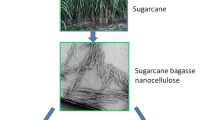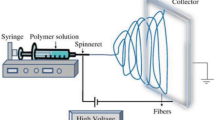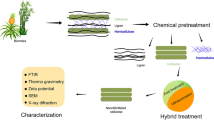Abstract
One of the most used carbonaceous materials by industry are carbon blacks, which have technological applications in polymeric composites, coatings and paints, electric and electrochemical devices. One drawback is that they are produced from fossil fuels. Although biochars are also carbonaceous materials some disadvantages like their larger particles size, high ash content and highly oxygenated surface must be overcome to enable their use as substitute of carbon blacks in composites. Sugarcane bagasse biochar was used to produce carbonaceous materials to substitute carbon blacks. Milling of biochar decreased particle size from several hundreds of micrometers to 100–500 nm and narrowed its size distribution. Chemical leaching reduced the inorganic compounds and ash content by almost 20%. Great advance was achieved when biochar was thermally annealed in alcohol vapor atmosphere which resulted in biochar-based material with very low oxygenated carbon species at particles surface and turned them hydrophobic. Almost no C–O/C=O and O–C=O peaks components were observed at the X-ray photoelectron spectroscopy spectrum. Reactive thermal annealing of the biochar based additive was a key procedure to obtain polyethylene composites (5% loading) with mechanical, thermal and colorimetric properties very close to the ones prepared with the carbon black from fossil fuels.






Similar content being viewed by others
References
CONAB (2017) Follow-up of the Brazilian sugarcane harvest (Season 2017/18)
Dias MOS, Junqueira TL, Cavalett O et al (2013) Cogeneration in integrated first and second generation ethanol from sugarcane. Chem Eng Res Des 91:1411–1417. https://doi.org/10.1016/j.cherd.2013.05.009
Gunun N, Wanapat M, Gunun P et al (2016) Effect of treating sugarcane bagasse with urea and calcium hydroxide on feed intake, digestibility, and rumen fermentation in beef cattle. Trop Anim Health Prod 48:1123–1128. https://doi.org/10.1007/s11250-016-1061-2
Cardozo E, Erlich C, Alejo L, Fransson TH (2016) Comparison of the thermal power availability of different agricultural residues using a residential boiler. Biomass Convers Biorefin 6:435–447. https://doi.org/10.1007/s13399-016-0200-3
Gollakota ARK, Reddy M, Subramanyam MD, Kishore N (2016) A review on the upgradation techniques of pyrolysis oil. Renew Sustain Energy Rev 58:1543–1568. https://doi.org/10.1016/j.rser.2015.12.180
Deng J, Li M, Wang Y (2016) Biomass-derived carbon: synthesis and applications in energy storage and conversion. Green Chem 18:4824–4854. https://doi.org/10.1039/C6GC01172A
Cha JS, Park SH, Jung SC et al (2016) Production and utilization of biochar: a review. J Ind Eng Chem 40:1–15. https://doi.org/10.1016/j.jiec.2016.06.002
Tripathi M, Sahu JN, Ganesan P (2016) Effect of process parameters on production of biochar from biomass waste through pyrolysis: a review. Renew Sustain Energy Rev 55:467–481. https://doi.org/10.1016/j.rser.2015.10.122
Kan T, Strezov V, Evans TJ (2016) Lignocellulosic biomass pyrolysis: a review of product properties and effects of pyrolysis parameters. Renew Sustain Energy Rev 57:126–1140. https://doi.org/10.1016/j.rser.2015.12.185
Cantrell KB, Ducey T, Ro KS, Hunt PG (2008) Livestock waste-to-bioenergy generation opportunities. Bioresour Technol 99:7941–7953. https://doi.org/10.1016/j.biortech.2008.02.061
Qian K, Kumar A, Zhang H et al (2015) Recent advances in utilization of biochar. Renew Sustain Energy Rev 42:1055–1064. https://doi.org/10.1016/j.rser.2014.10.074
Liu W-J, Jiang H, Yu H-Q (2015) Development of biochar-based functional materials: toward a sustainable platform carbon material. Chem Rev 115:12251–12285. https://doi.org/10.1021/acs.chemrev.5b00195
Santhiago M, Garcia PS, Strauss M (2018) Bio-based nanostructured carbons toward sustainable technologies. Curr Opin Green Sustain Chem 12:22–26. https://doi.org/10.1016/j.cogsc.2018.04.009
Nagarajan V, Mohanty AK, Misra M (2016) Biocomposites with size-fractionated biocarbon: influence of the microstructure on macroscopic properties. ACS Omega 1:636–647. https://doi.org/10.1021/acsomega.6b00175
Peterson Steven C, Chandrasekaran SR, Sharma BK (2015) Birchwood biochar as partial carbon black replacement in styrene—butadiene rubber composites. J Elastom Plast 1:1–12. https://doi.org/10.1177/0095244315576241
Van Soest PJ (1967) Development of a comprehensive system of feed analyses and its application to forages. J Anim Sci 26:119–128. https://doi.org/10.2134/jas1967.261119x
Peterson SC (2012) Evaluating corn starch and corn stover biochar as renewable filler in carboxylated styrene–butadiene rubber composites. J Elastom Plast 44:43–54. https://doi.org/10.1177/0095244311414011
Abdul Khalil HPS, Firoozian P, Bakare IO et al (2010) Exploring biomass based carbon black as filler in epoxy composites: flexural and thermal properties. Mater Des 31:3419–3425. https://doi.org/10.1016/j.matdes.2010.01.044
Ho MP, Lau KT, Wang H, Hui D (2015) Improvement on the properties of polylactic acid (PLA) using bamboo charcoal particles. Compos Part B Eng 81:14–25. https://doi.org/10.1016/j.compositesb.2015.05.048
Peterson SC (2012) Utilization of low-ash biochar to partially replace carbon black in styrene-butadiene rubber composites. J Elastom Plast 45:487–497. https://doi.org/10.1177/0095244312459181
Rodriguez A (2016) PEER-REVIEWED ARTICLE mechanical, chemical, and physical properties of wood and perennial grass biochars for possible composite application mechanical, chemical, and physical properties of wood and perennial grass biochars for possible composite application. BioResources 11:1334–1348
Ogunsona EO, Misra M, Mohanty AK (2017) Impact of interfacial adhesion on the microstructure and property variations of biocarbons reinforced nylon 6 biocomposites. Compos Part A Appl Sci Manuf 98:32–44. https://doi.org/10.1016/j.compositesa.2017.03.011
Huang JC (2002) Carbon black filled conducting polymers and polymer blends. Adv Polym Technol 21:299–313. https://doi.org/10.1002/adv.10025
Roy N, Sengupta R, Bhowmick AK (2012) Modifications of carbon for polymer composites and nanocomposites. Progr Polym Sci 37:781–819. https://doi.org/10.1016/j.progpolymsci.2012.02.002
Mesa-Pérez JM, Rocha JD, Barbosa-Cortez LA et al (2013) Fast oxidative pyrolysis of sugar cane straw in a fluidized bed reactor. Appl Therm Eng 56:167–175. https://doi.org/10.1016/j.applthermaleng.2013.03.017
Mesa-Pérez JM, Cortez LAB, Marín-Mesa HR et al (2014) A statistical analysis of the auto thermal fast pyrolysis of elephant grass in fluidized bed reactor based on produced charcoal. Appl Therm Eng 65:322–329. https://doi.org/10.1016/j.applthermaleng.2013.12.072
Qin H, Zhao C, Zhang S et al (2003) Photo-oxidative degradation of polyethylene/montmorillonite nanocomposite. Polym Degrad Stab 81:497–500. https://doi.org/10.1016/S0141-3910(03)00136-8
Abrusci C, Pablos JL, Marín I et al (2013) Comparative effect of metal stearates as pro-oxidant additives on bacterial biodegradation of thermal- and photo-degraded low density polyethylene mulching films. Int Biodeterior Biodegrad 83:25–32. https://doi.org/10.1016/j.ibiod.2013.04.002
Liu GL, Zhu DW, Liao SJ et al (2009) Solid-phase photocatalytic degradation of polyethylene-goethite composite film under UV-light irradiation. J Hazard Mater 172:1424–1429. https://doi.org/10.1016/j.jhazmat.2009.08.008
Su CY, Xu Y, Zhang W et al (2010) Highly efficient restoration of graphitic structure in graphene oxide using alcohol vapors. ACS Nano 4:5285–5292. https://doi.org/10.1021/nn101691m
Chrissafis K, Paraskevopoulos KM, Stavrev SY et al (2007) Characterization and thermal degradation mechanism of isotactic polypropylene/carbon black nanocomposites. Thermochim Acta 465:6–17. https://doi.org/10.1016/j.tca.2007.08.007
Chrissafis K, Bikiaris D (2011) Can nanoparticles really enhance thermal stability of polymers? Part I: an overview on thermal decomposition of addition polymers. Thermochim Acta 523:1–24. https://doi.org/10.1016/j.tca.2011.06.010
Shepherd C, Hadzifejzovic E, Shkal F et al (2016) New routes to functionalize carbon black for polypropylene nanocomposites. Langmuir 32:7917–7928. https://doi.org/10.1021/acs.langmuir.6b02013
Pielichowska K, Pielichowski K (2010) Crystallization behaviour of PEO with carbon-based nanonucleants for thermal energy storage. Thermochim Acta 510:173–184. https://doi.org/10.1016/j.tca.2010.07.012
Wellen RMR, Canedo EL, Rabello MS (2016) Crystallization of PHB/carbon black compounds. Eff Heat Cool Cycles 60008:60008. https://doi.org/10.1063/1.4965529
Acknowledgements
Prof. Liliane Maria Ferrareso Lona and Msc. Caroline Nogueira Kuchnier from the Chemistry Engineering Faculty of the University of Campinas (UNICAMP) are acknowledged for the use of injection molding system (Thermo Scientific HAAKE MiniJet II). Msc. Manoella da Silva Cavalcante and Prof. Edson Noriyuki Ito are thanked for the cryo-ultra-micro cuts of polymeric composites. Bioware Ltda company is acknowledged for biochar preparation service. Authors also acknowledge Brazilian Nanotechnology National Laboratory (LNNano) for the use of the SEM (proposal SEM-19904), AFM (proposal AFM-21346), XPS and µ-CT facilities. The National System of Laboratories for Nanotechnology (SisNANO/MCTI) is acknowledged for its financial support in infrastructure and equipment at the LNNano.
Author information
Authors and Affiliations
Corresponding author
Additional information
Publisher's Note
Springer Nature remains neutral with regard to jurisdictional claims in published maps and institutional affiliations.
Electronic supplementary material
Below is the link to the electronic supplementary material.
10924_2019_1468_MOESM1_ESM.docx
Supplementary material 1 (DOCX 32728 kb) Particle size distribution of the milled sugarcane bagasse pellets (SB) used as feedstock for the pyrolysis procedure and for the sugarcane bagasse biochar (SBB). Scanning electron microscopy (SEM) image of the particles of sugarcane bagasse biochar sample (SBB). Scanning transmission electron microscopy (STEM) images of the particles of sugarcane bagasse biochar samples ball milled for 6, 24, 48 and 72 h. Sugarcane bagasse biochar composition and surface chemistry analyses using XPS. Particle size counting statistics for the SBB-6h, SBB-24h, SBB-48h and SBB-72h materials. Carbon high resolution XPS spectra of the SBB-72h and rSBB-72h-ABL samples compared to SBB-72h annealed only under N2 (at 900 °C without isopropanol vapor). Vulcan XC72 carbon black information and characterization.
Rights and permissions
About this article
Cite this article
Ferreira, G.F., Pierozzi, M., Fingolo, A.C. et al. Tuning Sugarcane Bagasse Biochar into a Potential Carbon Black Substitute for Polyethylene Composites. J Polym Environ 27, 1735–1745 (2019). https://doi.org/10.1007/s10924-019-01468-1
Published:
Issue Date:
DOI: https://doi.org/10.1007/s10924-019-01468-1




